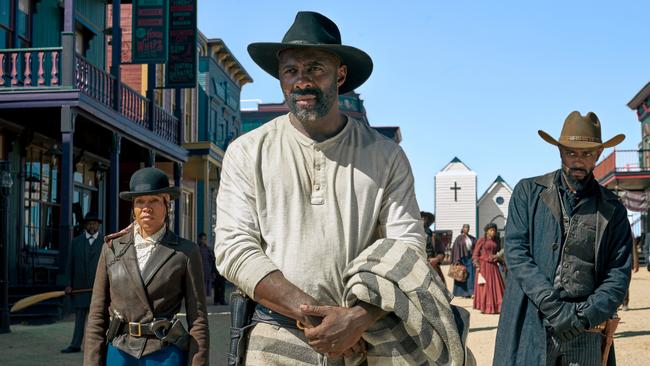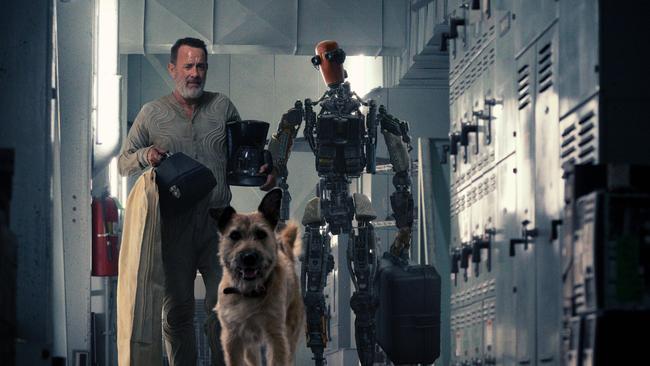The Harder They Fall, bloody but beautiful to watch
The release date for old-fashioned revenge western The Harder They Fall is not ideal, with the fatal shooting on the set of the Alec Baldwin western Rust in the headlines.

The Harder They Fall (MA15+)
In cinemas and on Netflix
★★★½
The Harder They Fall is an old-fashioned revenge western with different riders in the saddle than we see in a John Wayne shoot-em-up. All of the main characters are black. They are outlaws – male and female – and lawmen, drawn from historical figures.
The events are fictional, a title card reads, but These. People. Existed.
The film title itself appears when a man walks into a church and shoots another man. Shot one THE; shot two HARDER; shot three, which lifts him into the air, THEY; shot four FALL, and he is deader than dead.
The words are in red capitals and as the MA15+ rating suggests, this is a violent, pistols from dawn to dusk movie.
In that sense its release date is not ideal, with the fatal shooting on the set of the Alec Baldwin western Rust in the headlines.
It’s the feature debut of British singer-songwriter Jeymes Samuel, stage name The Bullitts, who co-wrote the script with Boaz Yakin (Now You See Me).
It’s set in the 1880s or so. The Civil War is over, slavery has been abolished but the scars remain.
The man doing the shooting is Nat Love (Jonathan Majors from Spike Lee’s Da 5 Bloods and the TV series Loki). The man being shot is one of the last on Nat’s hit list, but not the last.
The last is Rufus Buck (Idris Elba), the ruthless leader of a gang of bank robbers. He carries two golden revolvers.
We see those guns, but not the man holding them, in a brutal opening scene that happens a decade or so earlier and explains why Nat has a crucifix scar on his forehead and why he wants to kill Rufus. Rufus’s gang includes “Treacherous” Trudy Smith (Oscar-winning actor and director Regina King) and Cherokee Bill (a brilliant LaKeith Stanfield).
Nat’s includes shotgun-wielding Stagecoach Mary (Zazie Olivia Beetz) and the gender-hiding Cuffee (Danielle Deadwyler). There are no damsels in distress here. Delroy Lindo (who won awards for Da 5 Bloods) and Deon Cole are lawmen who are loose with the law.
With a cast like this, it’s hard to go wrong. Add a rapid-fire script, a soundtrack put together by the director that includes new songs such as My Guns Go Bang, by Jay-Z and Kid Cudi, and cinematography by Sean Bobbitt (12 Years a Slave, Judas and the Black Messiah) and Mihai Malaimare Jr (The Master, Jojo Rabbit) and the result is a stylish pulp western that is bloody but beautiful to watch.
There’s a bit of Quentin Tarantino (his frequent collaborator Lawrence Bender is a producer), a bit of Sergio Leone, a bit of Clint Eastwood (the sabre-marked face of the outlaw Josey Wales, for starters) and even a bit of Mel Brooks. The fastest draw in the west scene is funny, though not as funny as Gene Wilder in Blazing Saddles, and then tragic.
There are numerous set pieces that nod to the above filmmakers and other classic westerns, in tandem with some deliberate anachronisms that, along with the soundtrack, bust out of the setting. I don’t think, for example, the word “dipshit” was in use in the 1880s.
Underneath all of the gun slinging and fist fights in this 139-minute movie, there are stories of love and hate, present and past.
There’s a twist at the end when the two gangs meet and Nat and Buck come face-to-face.
There are reminders of the all-too-recent racist past, some obvious, some more subtle.
When someone describes Rufus as the devil, Delroy Lindo’s tough as nuts lawman replies, “I have seen the devil and Rufus Buck ain’t him. The devil’s white.”
According to the 1965 book The Negro Cowboys, an estimated 25 per cent of American cowboys were black.
In this well-made, well-acted film, a black director and black cast kick open the saloon door and let them in.
-
Finch (PG)
Apple TV+
★★★
The post-apocalyptic drama Finch opens with the title character, Finch Weinberg (Tom Hanks), walking alone through a windy, dusty street singing Don McLean’s American Pie. He’s wearing what looks like a hazmat suit.
He heads into a deserted supermarket, steps over dead bodies and scans the shelves. He’s not looking for whisky and rye, however, but for dog food. When he finds a tin he celebrates. “Okay, someone’s going to be happy tonight.”
That someone is a dog named Goodyear (played by a dog named Seamus). As in the 2000 film Castaway, where Hanks grew fond of a volleyball named Wilson, his closest companion in this messed up world is not human.
“I think about you all the time, of course I do,’’ he tells Goodyear on return to his bunker home. The look on his face, though, suggests there once were others he thought about more. It’s a fine moment of acting by the dual Oscar winner.
The reasons the world is on life support is not spelled out. However, when we see the books Finch reads we can guess it’s an environmental catastrophe that turned the ozone layer into “Swiss cheese”, as he puts it later. He’s in St Louis, Missouri, and the computer he wears on his wrist tells him it’s 150 degrees Fahrenheit.
And while Goodyear is all Finch, who worked in the tech business, has left to care about, it’s another character who becomes the centre of this survival story: a robot he has brought to life.
When Finch asks the android to recite the laws he is programmed to obey, the first one comes straight from Isaac Asimov: Do no harm to humans and let no harm come to humans. The fourth and final one, which supersedes the previous three, is new: Protect the dog.
While this movie, directed by Miguel Sapochnik, who won an Emmy for his work on Game of Thrones, is a dystopian drama, it is not short of laughs. Hanks has worked with a dog before, in the 1989 movie Turner & Hooch.
Yet it’s the robot who is the supporting star this time. Voiced and motion capture acted by Caleb Landry Jones, who is so good as the Port Arthur gunman in Justin Kurzel’s Nitram, he starts out like a child and then becomes a sulky teen. He’s smart, a fast learner and, as Finch realises when he needs to change a tyre without a jack, super strong. When they discuss a name, the robot suggests ones he has seen or heard, such as Jack, Rover, William Shakespeare and Napoleon Bonaparte, before settling on Jeff.
“I know you were born yesterday,’’ Finch tells him, “but it’s time for you to grow up.”
That growing up happens when the man, dog and robot, aware a superstorm is coming, start up their recreational vehicle and decide to head west.
This die or live decision is reminiscent of Cormac McCarthy’s novel The Road, which John Hillcoat filmed in 2009. Finch is the only human in sight, but he believes others are about and they are killers and cannibals.
He sings, several times, another line from American Pie: “This will be the day that I die.”
As in numerous recent films and books, a pivotal question is: can artificial intelligence think for itself? And if it can, what does that mean for the humans who created it, and in this case their dogs?
As he matures, it seems Jeff might have a mind of his own. So might Goodyear and one of the funniest scenes needs no human input. “Hello, dog,” Jeff says when the two are introduced. “I know 16,000 interesting facts about …” Goodyear cuts him off in a way only a dog can.
The first half of this 115-minute film is tight and striking. It takes us to a world that we might inherit and Hank’s performance is powerful. The second half becomes a bit unfocused and sentimental for this viewer.
This is Hanks’ second recent film for Apple TV, the first being the fine World War II ships versus submarines adventure Greyhound, which he also wrote.
His next film, due in June, sees him return to a big studio and a role that will exercise his acting chops. He is Colonel Tom Parker in Elvis, Baz Luhrmann’s take on the life and death of the king of rock‘n’roll.





To join the conversation, please log in. Don't have an account? Register
Join the conversation, you are commenting as Logout